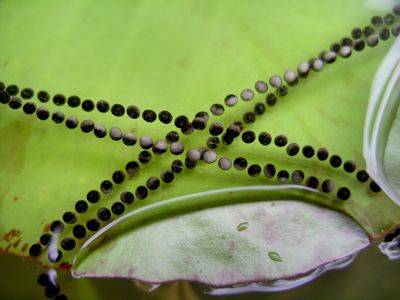
Rio Grande leopard frog eggs
A long time ago, I learned that one way to tell frogs and toads apart was by the form of their egg masses. That proved to be a simple and useful factoid that added understanding to my other observations through the decades. From clumps of cricket frog eggs found in shallow streams to the elegant strings that toads laid in our ponds, anuran eggs have always fallen into one category or the other.
 Rio Grande leopard frog eggs |
A totally different kind of song signals the presence of cricket frogs (Acris crepitans), which are very common in any creek with moisture here in central Texas. The voice of this warty little amphibian sounds exactly like two rocks being repeatedly struck together. In fact, at the peak of the mating season, simply using a couple of small stones to mimic the calls will prompt any males within earshot into a retaliatory chorus. Even though cricket frogs have bumps and knobs all over their skin like toads, they are undoubtedly frogs and their eggs confirm it. The familiar messy globs can be found attached to vegetation in the stream.
 Gulf coast toad eggs |
There is a very good chance that any toad seen here in Austin will turn out to be a Gulf coast toad (Bufo nebulifer). These ubiquitous residents of woodland streams and irrigated backyards will use any runoff retention area or garden pond as a nursery for their tadpoles. During the spring, a reasonable rain shower will coax the males to produce their loud and lengthy trilling call. The bigger the animal, the deeper and more powerful the tone. As the water surface helps amplify the noise (and bigger is always better for these toads), several competing males create a cacophony equal to an intrusive and unstoppable alarm clock. The eggs are beautifully spaced black spheres set within crystalline gel cords. The sunrise after a particularly productive mating session will often reveal a network of long egg strings, threaded every which way around the vegetation at the water's surface.
Although we have several other amphibian species, in my 35 years as an Austin resident, I've only witnessed the reproductive activities of the three I just described. They are hard to miss. So my curiosity was piqued when this past spring, on a butterfly survey conducted at a private ranch just southwest of town, I heard a different sort of call. Recent rains had made the usually parched, rocky landscape come alive with plenty of fresh green growth, and there were even temporary ponds in the drainage basins. While near one of the larger pools, the unmistakable sound of frogs drifted across the water from the far side. They were unlike anything I've noticed before: sort of like the cry of a tiny sheep. There was a lot of tangled vegetation, but I just couldn't resist trying to see the little singers. I already had an idea of what they might be, as I'd read a description of such a call, but wasn't really sure of my memory's reliability.
 Great Plains narrowmouth toad eggs |
As soon as I got home, I checked on my best guess as to the identity of the mysterious eggs. It was an easy ID. The description in my field guide of the Great Plains narrowmouth toad (Gastrophryne olvacea) eggs was spot on. The unique vocalization is described as "bleating" and a related species in the same family, as I vaguely had remembered, is called the sheep frog.
Due to our rather hot climate, along with the unpredictability of rain, the diversity of amphibians in our area is not impressive. This is arthropod territory, an animal group that can withstand desiccation, intense sun exposure and wide temperature swings. But that doesn't mean there are not at least a few incredibly adapted tender water-loving organisms. After all, it might be hot and dry but it's not a desert. We sometimes get plenty of precipitation, albeit in the form of flash floods!